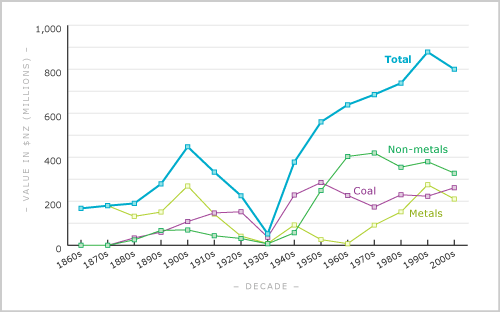
This graph shows the value of minerals to the New Zealand economy between 1860 and 2004. Values have been adjusted for inflation to 2004, and have been averaged over five-yearly intervals to minimise the effect of small fluctuations.
There has been a steady increase in the total value of mineral production since 1920 although the proportions of different commodities have changed. In particular, the value of gold production dropped sharply after 1940, but this was more than offset by the rise in production of non-metals due to the increase in construction of buildings, roads and dams after the Second World War. The inflation-adjusted value of coal production has remained remarkably constant since 1920.
Using this item
Te Ara - The Encyclopedia of New Zealand
This item has been provided for private study purposes (such as school projects, family and local history research) and any published reproduction (print or electronic) may infringe copyright law. It is the responsibility of the user of any material to obtain clearance from the copyright holder.
Source: Annual Parliamentary reports of the Mines Department (later Ministry of Energy, then Crown Minerals, Ministry of Economic Development)










Comments
Nice
Scienceguy303 (not verified)
16 September 2013
Add new comment